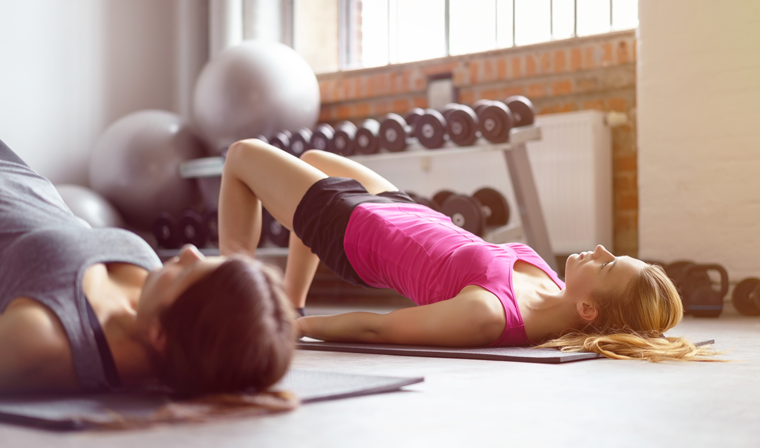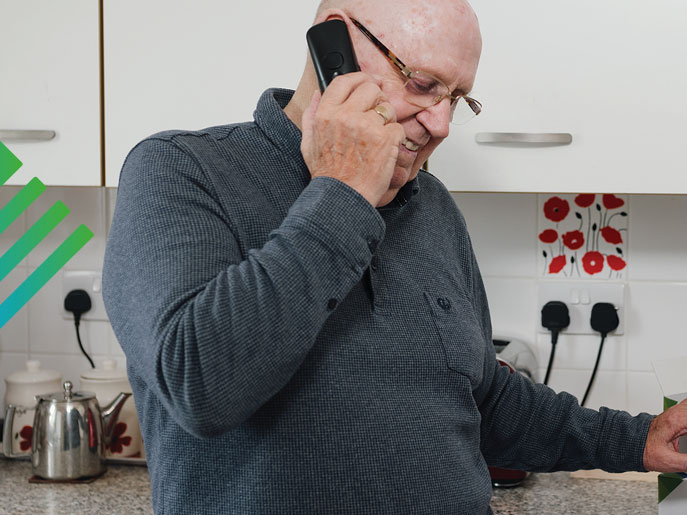Benefits of exercise for people with a stoma
Aside from quicker recovery and a better quality of life all round, there are other benefits to exercise:
- Helps prevent illness
- Stronger heart
- Better balance and flexibility
- Better concentration
- Reduce stress
Early days

Before and after your surgery, you will have discussions with your stoma nurse about exercise, its benefits and when it is safe to resume. They will usually teach you how to cough properly after surgery and provide breathing exercises to aid you in your recovery
You may have attended 'surgical school' pre-operatively if your hospital offers this service. This is a common part of many hospitals enhanced recovery programmes, where you'll learn how to safely get in and out of bed after abdominal surgery, along with some simple exercises that are safe to do immediately.
- The first gentle exercises that are safe and easy to do include lying on your back on the bed or floor with your feet off the floor and knees above your chest. Slowly roll your knees from side to side just as far as you can comfortably. Please seek advice from the physiotherapist on the ward, especially if your wound still has staples or stitches or hasn’t healed.
- An easier exercise would be to lay on your back as above and slowly tilt your pelvis forwards then back to flat position just as many times as is comfortable to do so.
- You can also sit on your chair with your feet flat on the floor – you may need to shuffle forwards to do this. Pull in your tummy muscles if possible and breathe in. Stand slowly whilst breathing out but still keeping your tummy pulled in if possible. Try to build up to 10 of these ‘sit to stand’ exercises and aim to do them twice a day.
- Whilst sitting forwards in your chair and feet flat on the floor, pull in your tummy muscles then slowly raise 1 foot approximately 10cms from the floor whilst breathing out. Lower that foot then do the same on the other side.
All will be encouraged (if able) to get out of bed as soon as possible and start short walks. The ward staff, physiotherapists or enhanced recovery team may also facilitate this.
The best exercise you can do straight after surgery is walking. It may be helpful for you to set yourself small, manageable goals to start with and slowly increase the distance when and if you feel your body is ready for it. Let your body heal and don’t push yourself too much to begin with!
Getting back into it

Getting back into a healthy, active lifestyle after stoma surgery is essential. You should do this as soon as you feel you’re able and everyone is different, there are many factors that determine your recovery period such as age, fitness level before and the list goes on, so work at your own pace. Discuss any concerns with your stoma nurse or district nurse if you still have wounds that are healing.
A beneficial thing for you after stoma surgery is strengthening your abdominal muscles as it can help to reduce the chance of a hernia or prolapse. Wearing a hernia belt or ostomy support belt is often recommended in current guidelines to prevent both parastomal hernia and prolapse. The guidelines emphasise assessing the individual needs to determine the appropriate type and level of support, considering factors such as lifestyle and daily activities. Your stoma nurse can provide more guidance on this and even refer you.
Tips for Exercising with a stoma

- Drink water, juice or isotonic sport drinks to avoid dehydration
- Wear comfortable clothing and shoes
- Wear a hernia or ostomy support belt to help prevent a parastomal hernia or prolapse if recommended by your stoma nurse or hospital team
- Ensure you are pain free and have emptied or changed your pouch before starting any exercise
Abdominal Exercises – For strengthening your core
Some abdominal exercises that you can do to strengthen your core include the ones mentioned above. You can also attend gentle yoga, Tai Chi or Pilates classes provided you speak to the instructor before starting and explain the surgery you have had. It is generally not advisable to attempt sit ups or plank exercises.

Lifting weights should not be attempted for 12 weeks and start on the lightest weight then slowly build up. Start at home by sitting upright in your chair, pulling in your tummy then slowly raise each arm in turn whilst holding something such as a can of soup or baked beans. It is important that you breathe in whilst pulling in your tummy then breathe out whilst performing the exercise.
Please don’t hold your breath as this raises the pressure inside your tummy.
Swimming with a stoma
Many ostomates fear swimming with a stoma because they’re scared it might leak or because they’re nervous of people looking. Some even think that you can’t swim because you have a stoma bag now which is completely untrue.
Almost every stoma bag these days are water resistant and will not leak if fitting correctly. If you’re still unsure or anxious, some ostomates prefer to wear a smaller ileostomy, colostomy or urostomy bag or even a stoma cap which is a little less noticeable – speak to your stoma nurse who can advise on different products. Wearing a patterned swimming costume makes the pouch less noticeable rather than a plain one. You don’t have to buy a special costume, try any from the high street or order online if you feel more comfortable doing so.

Tips for swimming with an ostomy
We have some tips for swimming with an ostomy:
- Wear whatever makes you comfortable. You should wear whatever you feel good in, swimming is a fun activity, and you don’t want to feel uncomfortable. There is a good variety of different swimwear out there, including ostomy swimwear.
- Carry extra supplies.
- Check your pouch seal. You may want to check that your bag is extra secure by using additional products such as flange extender for your peace of mind.
- You may be advised not to swim if you are receiving chemotherapy or radiotherapy treatment – please speak to the specialist team looking after you if this is the case.
- Do not go swimming if you have an open wound, staples or a drain insitu.
If you have never exercised before, please seek advice from your stoma nurse or other healthcare professional before starting a new regime.
Exercise has many benefits however you must carry it out safely and carefully. Many hospitals have a cancer survivorship programme for those that this applies to which includes post-operative exercises.
Other areas may provide written information packs with exercises or give you verbal information post operatively before discharge home.
Please ask your stoma nurse if you are unsure as they can signpost you to the correct information. Above all, listen to your body! Whilst it is important to keep moving, you should always stop if you feel pain or become unwell.

Need support or advice?
If you need any further support or advice, then please contact Medilink® today. You can call us Monday to Saturday, from 9am to 5pm, on Freephone 0800 626388.